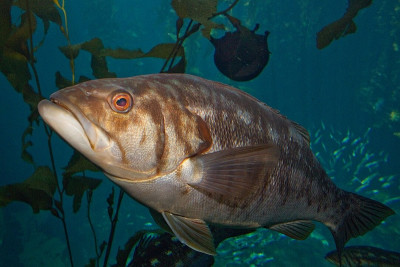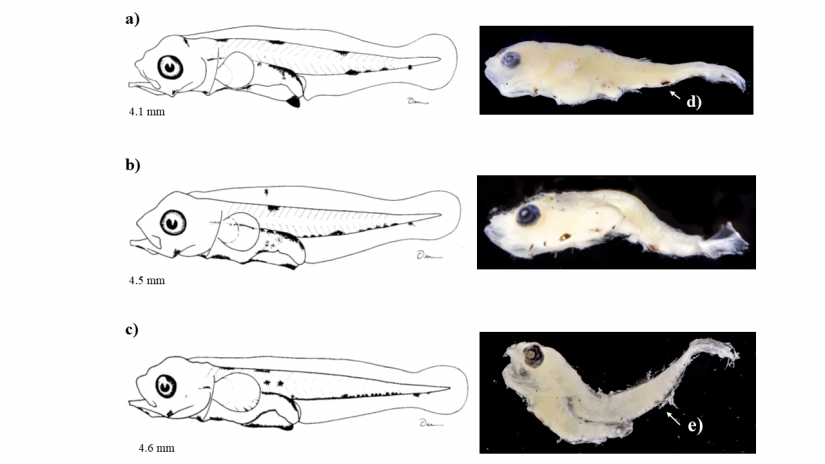This is the third in a yearlong series of stories showcasing the research that the Ocean Protection Council supported in partnership with California Sea Grant, with funding from Proposition 84.
Barred sand bass are iconic fish in California, one of the key targets of the world’s largest for-hire sportfishing fleet. Its vessels, which can hold as many as a hundred passengers, roam the state’s coastline nearly every day of the year, sometimes making several trips in a day. It makes for a bustling economy, to the tune of $3 billion a year. Worryingly, though, despite protective harvest restrictions put in place in 2013, the catch of barred sand bass is dwindling.
The fishing vessels like to target the bass’s massive spawning aggregations. Every summer, the fish would congregate at the same few locations up and down California’s coast.

“But they haven’t done that in ten years,” says Erica Mason, who received her doctoral degree from Scripps Institution of Oceanography at the University of California, San Diego, last August. This makes scientists believe the populations are depressed. But it’s hard to know for sure precisely how much they are depressed.
Until 1975, barred sand bass was grouped with the two other species in the genus Paralabrax as “Rockbass” in official catch records. Other sources of data aren’t much help either. The largest existing data series for Paralabrax — a collection of larvae compiled by the California Cooperative Oceanic Fisheries Investigations (CalCOFI) — also lumped the species together, in part because no one had ever figured out a reliable way to tell the larvae apart.
“Because of that, we’ve always lacked that really long-term data on their populations,” says Mason, who now works for the National Oceanic and Atmospheric Administration’s Southwest Fisheries Science Center. That’s made it difficult to tease apart the impacts of harvest from environmental effects. And in the era of climate change, that lack of information is worrying.
“The farther you can go back to see what the historical baseline was, the better able you are to assess trends,” Mason says. For her dissertation, she decided to take another look at those old samples.
In the 1980s, NOAA researchers had attempted to develop a “taxonomic key” for larval Paralabrax — a guide to distinguishing these species’ larvae. They’d made some progress but never found a set of identifiers that was consistently reliable. Working under the mentorship of Andrew Thompson and William Watson, ichthyologists in the Ecosystem Science Division at the Southwest Fisheries Science Center, Mason picked up where her predecessors left off by combining classical taxonomic techniques — looking under a microscope to discern differences — with cutting-edge technology like DNA sequencing and machine learning. It’s a methodology that could be useful for other data-limited species, too, she notes.
Mason created a taxonomic key, based on pigmentation, that distinguished all three Paralabrax species (barred sand bass, kelp bass, and spotted sand bass) across all three stages of larval development at a 96% rate of accuracy. Mason first published a scientific paper describing the most up-to-date methods to identify not just basses but multiple larval fish that are difficult to identify. She then used her newly-developed recipe on CalCOFI’s samples and was able for the first time to quantify the breakdown of Paralabrax species collected every July since 1963.

Her detective work didn’t stop there. Next, Mason built what’s known as a “standardized index of abundance” for barred sand bass and kelp bass: Using a model that helps clean up the data, she adjusted the figures for, among other variables, the kind of sampling gear employed and the day of the season the sample was collected.
Such standard indices of larval abundance are considered the most reliable tool to monitor adult population trends through time: Since reproductive females usually produce comparable amounts of larvae, knowing larvae abundance allows us to estimate how many females were around in the past. Using larvae to look forward, to predict catch, is more complicated, as many factors influence how many young fish survive into adulthood. But Mason was excited to note that, at least for barred sand bass and kelp bass, her new indices predicted the future catch extremely well. That could create better fisheries forecasts.
With the once-murky Paralabrax picture in new clarity, there is a path forward for new management approaches. “These three species are very similar in terms of what they look like and how fast they grow,” Mason says. “But in other ways, they’re so different.”
Barred sand bass, she found, do better when the ocean is warmer. “We tend to see more barred sand bass recruits following warm water events, like a strong El Niño,” Mason says. She suspects the U.S. barred sand bass population is primarily dependent on larvae that hitch a ride north with water masses from Baja California, Mexico, during such warm weather events.
“When you combine fishing on spawning aggregations with recruitment events that are only few and far between, that's going to make the population extremely vulnerable to harvest impacts.” Though Mason notes one positive fact: Her data showed that larval abundance for both kelp bass and barred sand bass peaked in recent years, which suggests that climate change, alongside appropriate harvest protections, might help these species recover.